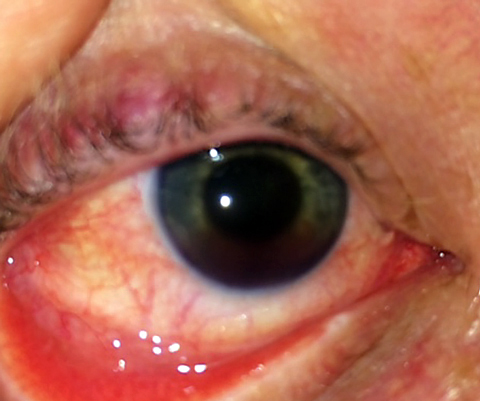 |
| Hospital-based ophthalmology ER consultations reached a peak in September and were lowest in April, study finds. This patient was struck in the eye with a wiffleball while playing with his son. Photo: Joseph W. Sowka, OD. Click image to enlarge. |
Warmer temperatures and longer days allow for more leisure activity—and, with it, a greater number of eye injuries. So says a new study in Ophthalmic Epidemiology.
The high volume of emergency visits involving the eye puts a strain on ER providers, particularly in hospital settings without regularly available ophthalmology coverage. Hospitals with in-house ophthalmology coverage tend to be associated with larger academic centers affiliated with numerous sites, oftentimes including a trauma center. Similarly, many rural counties in the United States with low population density may suffer from a scarcity of coverage. The ability to predict the frequency of ophthalmology consultations may allow for more effective use of resources and minimize strain on consulting physicians across the spectrum of eye care. Researchers at the University of Maryland School of Medicine recently found that higher daily maximum and minimum temperatures were associated with significant increases in rates of emergency ophthalmology consultations at a single institution.
The study included hospital-based ophthalmology consultations of 3,877 patients between 2015 and 2020 at the University of Maryland Medical Center. Weather data from the National Climatic Data Center for Baltimore was matched to the day of the initial encounter.
The research team noted that there was not a strong association between precipitation and overall incidence of emergency consultations as they had predicted. They also found a trend toward higher rates of ophthalmology consultations in the summer months of July, August and peaking in September, with a decline in rates of emergency consultations in the winter and spring months of February, March and April.
“Although our study was performed in a mid-Atlantic city with moderate seasonal variation in temperature and precipitation, our findings may not be generalizable for ER settings in climates with varying seasonal weather patterns,” the authors of the paper wrote. “Similarly, our study is performed in a city that typically sees a limited amount of winter precipitation, particularly snowfall; thus, regions with greater rates of winter precipitation may have greater fluctuations in frequency of ophthalmology ER consultations.”
The researchers believe these results should prove useful to eyecare providers and ER staff who may be able to better prepare for differing rates in ocular emergencies during the year and to mobilize the necessary personnel and resources to manage these consultations.
“In a healthcare system with decreasing access to primary care in the outpatient setting, those providers who do provide emergency eye care may continue to shoulder the increased burden,” they wrote. “Given that many general ER ophthalmologic consultations are for lower-acuity conditions such as corneal abrasions or conjunctivitis, the urgency with which patients seek medical care may be more strongly influenced by weather patterns.”
Bergman ZM, Munir SZ, Munir WM. Weather patterns and the frequency of ophthalmology consultations in the emergency setting. Ophthalmic Epidemiol. March 21, 2023. [Epub ahead of print]. |


